Handball drills
This can be done in groups of 2 or 3 players.
- This is to get used to receiving the ball in motion, facing the goal.
- This is a passing exercise as well.
- Let's take a group of 3 players.
- There will be two cones on the floor, at around 10 meters, on each side of the centre back, and 2 cones at the 7 meters in front of the half backs.
- The centre back has the ball, and for the half back to receive the ball, they need to start behind the cone of the 10 meters, and run in front of it.
- The centre back can only pass the ball in the direction after the cone. Once the half back receives the ball, they will do two/three steps towards the 7 meter cone, stop, and pass the ball back to the centre half who must start before the 10 meter cone and receive the ball after it.
- The half back then returns to their spot and the centre back continues the exercise with the other side half back.
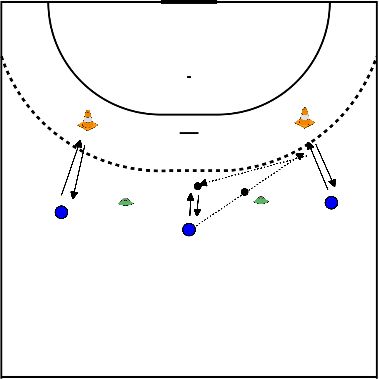
- Depending on how many players there are you can use the full 6/9 meters or just a part of it.
- The defending players will hold hands two by two (so if there are 6 players, there will be 3 groups of 2).
- The attacking players will pass the ball around between themselves and around the area trying to "destabilise" the defence and find a gap so they can run in and touch down with the ball in the area.
- If the 2 groups of the defending players touch the attacker, the point does not count.
- if only 1 of the groups of the defending players touch the attacker, the point counts.
- If none of the groups of the defending players touch the attacker, it counts 2 points.
The goal is to get to 8/10 points (depending on how many 2 points they score) and then swap.
- If there's few players, shorten the court and if there's an uneven number, the defence stays with one less.
Pay attention:
- No lob passes
- No more than 3 passes
- No bounce (if possible)
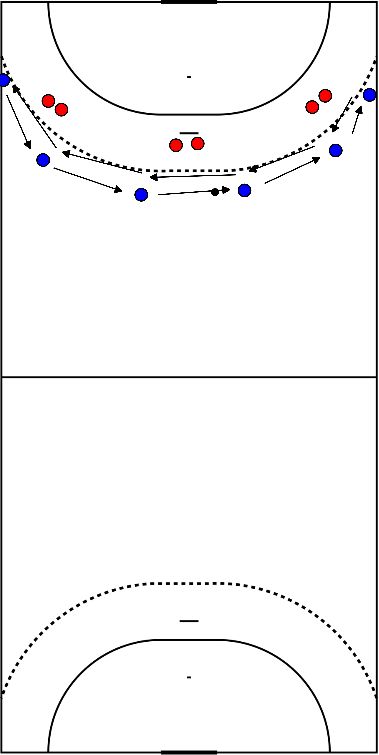
This can be done with groups of 3 to 7 - odd numbers ideally.
- Let's assume a group of 5 players.
- We'll have 3 attackers and 2 defenders.
- The 3 attackers will have a delimited running corridor in a straight line and they will have to pass the ball from one to the others while the 2 defenders will have to try and intercept the passes. The defenders have freedom of movement.
- The exercise can evolve in the types of passes in order to foster movement without the ball.
- First all types of pass, then no lob passes, then only bounce passes.
If the defenders intercept the pass, they continue the exercise acting as the attacking players in numerical inferiority. The 3 attacking players now have no restriction of movement.
This is to be done slowly at first, not as a fast break, to instill the idea of moving without the ball first. The speed can be adapted as the exercise goes on.
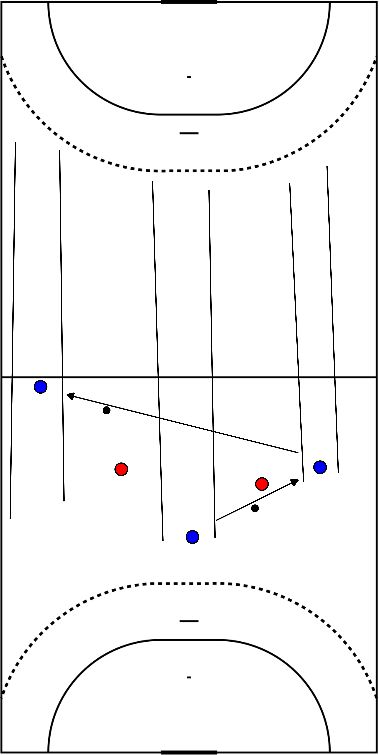
- Make 4 compartments (size depends on the size of the team)
- Everyone starts tipping in box 1
- If you tip the ball away from someone else, you may move up one square.
- Winner is the first to leave the last box
- Little 8 is the change of circle with the corner players.
- Middle build-up indicates which system is started. At small 8 the corners and circle start running;
- The right corner takes the initiative and runs towards the position of the circle (can be with or without ball!), the circle runs towards the corner and perhaps takes a defender with it. This may free up the circle which can be played through the build-up. If not, the substitute moves on to the other corner, until either a goal is scored or everyone is back in his/her own place.
- Important is watching each other's timing, not getting in each other's way and correct passing with bounce by the builder.
- Practice start with passive defenders, then active
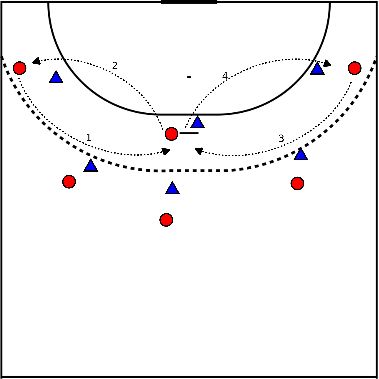
- Have the players practice performing different feints, in the beginning without the ball, as soon as the movement is done well, perform the same movement with a ball.
- Have the players play together in pairs, feinting each time they receive the ball.
- Have them practice a 0 pass on 2 legs.
- Perform the 0 pass on 1 leg.
- Perform the 0 pass on the other leg.
- Have the players perform an 0-pass followed by a feint (shot arm side)
- Having the players make an 0 pass followed by a feint (not shot arm side)
Divide team into 3 teams.
- Team 1 starts defending
- Team 2 starts attacking from the middle
- Team 3 gets ready on the middle line with ball
Once completed, team 2 starts defending and the 3rd team starts attacking from the middle.
- Team 1 takes the ball and gets ready on the middle line, etc.
The goal is to switch quickly from attacking to defending.
- Burpee (lie on stomach, press up, place hands on floor while "jumping" feet between hands, then explosively jump up with arms raised)
- Abdominal muscle crunches
- Plank from hands to elbow
- Lunges
- Penguin; lie on back, legs bent with hands left/right ankle tapping.
- Squat
All positions at least occupied by 1 player with ball
On follow order is completed:
On follow order is completed:
- Right corner: round off with lop
- Right formation: round off with underhand shot (possibly 2 boxes with mat to create opening)
- Center formation: round off with jump shot over an F goal/mat (this is at 9 m)
- Left formation: round off with a dummy around the post
- Left corner: free choice of rounding
- Circle runner: turn and jump with 2 legs at the same time
Having rounded off choose another position
Goalkeeper gets a vest which he/she throws up, holds up ball and must catch the vest before it hits the ground. (or holds balloon in the air during exercise) Pay attention to goalkeeper posture (hands high, knees bent)
Goalkeeper gets a vest which he/she throws up, holds up ball and must catch the vest before it hits the ground. (or holds balloon in the air during exercise) Pay attention to goalkeeper posture (hands high, knees bent)
- 2 rows of players at 11 meters
- dribble and jump on run shot
- hands
- left/right high
- left/right low
- ground
Keeper indicates himself takes charge of this exercise
- Middle build-up indicates moment and system starts at Left corner
- Right corner goes deep
- Right corner takes up its position more to the right and applies pressure
- Left corner puts pressure
- Left corner puts pressure and walks backwards
- Center structure puts pressure on the left with the aim of taking center defender with it and then barricading/holding it with it
- Circle runner secures circle defender
- Left post runs behind Center post and receives the ball
Note: Right corner and Right build-up also put pressure to the right to keep defender with them so that Left build-up gets space
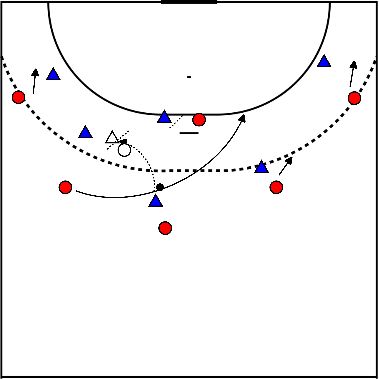
- 2 a 3 hunters throwing off players with a soft ball
- Ratio; 1 to 5.
- Head is sacred and may not be touched and play with handball rules.
- If you are thrown off you sit on the bench.
- The 2 or 3 players who are thrown off first become the hunter in the next game.








